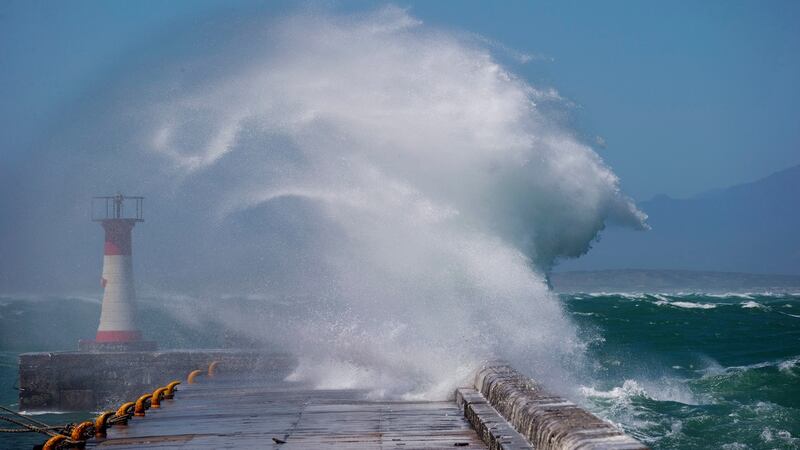According to historian Adam Tooze, we are living in the era of the polycrisis, where multiple, overlapping and compounding crises are challenging the way we live.
Tooze refers to shocks emanating from the pandemic, the energy shock resulting from war in Ukraine, a breakdown in relations among great powers, slow growth, rising inequality, over-reliance on credit, and a decade of ultra-low interest rates that have led to financial fragility worldwide.
And, of course, perhaps the most existential threat of all, climate change.
Having navigated the pandemic, Ireland now finds itself in the grip of an inflation crisis, one that is slowing growth and weighing heavily on living standards. While nominal wages are growing, real wages are contracting at a rate not seen since the grim days of austerity that followed the 2008 financial crisis.
RM Block
And while the public finances remain strong, spending pressures related to an ageing population and the Green transition are mounting.
This year had promised to be a bounce-back one, where built-up demand and elevated savings from the pandemic would drive strong growth. However, it was quickly overtaken by Russia’s attack on Ukraine and the ensuing surge in energy prices.
‘Headwinds appear inevitable over the coming months. A recession in Ireland, however, is not.’
— Dermot O'Leary of Goodbody Stockbrokers
In the face of war, elevated inflation, rising interest rates and likely recessions in the euro zone, the UK and elsewhere, the outlook is more uncertain than ever. We asked four senior economic commentators to give us their predictions for the year ahead.
Dermot O’Leary, chief economist with Goodbody Stockbrokers
Given the recent experience of unexpected viruses and brutal wars upending short-term forecasts, we are minded to be humble about our prediction abilities. As is attributed to the former American baseball player Yogi Berra, “it’s tough to make predictions, especially about the future”.
With this caveat, there has been rarely much agreement on the economic prognosis for the wider global economy. We are likely now already amid a rolling series of recessions in the developed world that will continue for much of next year. The UK and the euro area began this journey in recent months due to a combination of factors such as the energy price shock, squeezed disposable incomes and business uncertainty due to geopolitical events such as the war in Ukraine and Brexit. The US economy continues to grow, but tighter monetary settings are likely to tip the economy into recession by the middle of 2023.
Against this backdrop, Ireland is vulnerable to weakening international demand for its exported goods and services. Like other countries, Irish households also must deal with large hits to their disposable incomes due to multi-decade highs in inflation. These headwinds appear inevitable over the coming months. A recession in Ireland, however, is not. There are now several distinguishing features that were absent on the eve of the global economic downturn in 2009. Firstly, household’s balance sheets, in aggregate, have never been in better shape. Having been among the most indebted in Europe in 2007, household debt is now in line with the average across the region. In addition, saving behaviour has not yet reverted to “normal” pre-pandemic levels.

Secondly, the Government can ease some of the financial burden on households and businesses due to its budget surplus. Thirdly, banks are in a much stronger position to support ongoing activity through lending rather than the damaging deleveraging endured from 2008 onwards.
This is also true globally, suggesting that the weaker period ahead will not represent a short, sharp downturn, but it is more likely to be elongated given ongoing high energy prices and the reduced scope for stimulus because of stubbornly high inflation. The biggest upside risk to this view, however unlikely, stems from a quick end of the war in Ukraine.
Frances Ruane, chairperson of the National Competitiveness and Productivity Council
A slowdown in global economic growth coupled with changing patterns of globalisation, a new interest rate environment and the highest inflation rates in over three decades, weigh heavily on Ireland’s economic outlook for 2023.

This year’s annual report of the National Competitiveness and Productivity Council identifies actions that Government should take to improve Ireland’s competitive position in the face of this economic uncertainty. These actions relate to the levers available to Government that can make a difference to our competitiveness. They include targeting investment of public funds to enhance productivity and policy measures to increase competition and efficiency in domestic markets.
We know from our past the costs of delaying critical investment. Notwithstanding higher interest rates, the Government must press ahead with the critical investments in housing, energy and other public infrastructure to generate more sustainable and inclusive economic growth. Alongside continued investment, the pace of delivery – particularly at the planning stage – must improve so that targets in these areas are met. For example, there should be no delays in reaching decisions on the recommendations in the recently-published planning report.
A more effective and urgent implementation of these “no-regrets” polices is key to improving living standards and wellbeing across society. In addition, targeted interventions to support innovation and skills will set Ireland on a more sustainable path as we address the challenges and seize the opportunities from the twin digital and climate transitions.
In today’s challenging environment, there is no room for complacency in implementing agreed policies. The tectonic changes under way present us with opportunities but we must recognise that there are very real costs to inaction and delay.
Eddie Casey, chief economist with the Irish Fiscal Advisory Council
On the face of it, 2022 was a year of recovery from the pandemic with activity bouncing back, unemployment reaching once-in-a-generation lows of 4.2 per cent and buoyant tax revenues. But the Russian invasion of Ukraine in February derailed any idea of a quick return to normality.

Households and businesses have faced huge increases in energy prices, putting many people under enormous pressure. Inflation has reached its highest rates in decades, both in Ireland and internationally. Interest rates have gone up sharply. Growth has slowed.
While the economy has been resilient so far, the winter months and the rest of 2023 will be a testing time.
The Government faced a difficult balancing act with Budget 2023. It had to respond to the energy shock, support households on lower incomes and avoid adding to domestic inflationary pressures by putting too much money into an economy at full employment.
The budget looks to have struck that balance about right. The package of permanent and temporary measures largely focused on the cost of living and was anchored by the Government’s new spending rule. This should keep prices on a downward path and allow the budget balance to improve. If further shocks can be avoided, Europe reducing its dependence on Russian gas should help lower price pressures further and return us to growth.
But, even if we have done a good job managing recent crises, we should not ignore the need to plan for future challenges. Ireland’s baby-boomers are inching towards retirement, climate change continues indifferent to our conflicts, and we remain over-reliant on corporation taxes from a handful of superstar multinationals.
We might hope for an easy start to the new year but, as Neil Young wrote about the battle with entropy and change, “rust never sleeps”. We will have to keep adapting to new and profound challenges.
Gerard Brady, head of national policy and chief economist with employers’ group Ibec
With 2022 almost behind us, most businesses are now well into planning for 2023. Feedback from businesses is mixed. Many in our exporting sectors are continuing to grow. Others in the domestic sector are looking into a Christmas period that promises to be busy. Beyond Christmas, however, many businesses look forward to 2023 with trepidation.
A reliance on more expensive sources of energy puts Europe and Ireland in a competitiveness bind, the only escape from which is greater investment in our low-carbon future.
In the aftermath of the financial crisis, central banks loosened the taps of monetary policy to support the global economy. As a result, the past decade has seen the lowest interest rates globally on record. Next year will see those monetary taps turned off, to try to tame inflation. The state of the global economy next year will be determined by the success or failure of central banks in this goal.
Some sectors are already experiencing turbulence from rising interest rates. In sectors where valuations were driven by cheap capital betting on big returns, the realignment of equities with earnings has dented expectations. Tighter capital will be a particular challenge for start-ups and for those, such as parts of the property industry, where they compete for investment with “safe” assets like treasuries.
As we emerged from Covid, a rapid recovery in consumer demand overwhelmed the infrastructure that supports global supply chains and drove inflation. In the US, recent data suggests that their demand-driven inflation may be near its peak. An early US recovery would help drive a return of global investment. Feedback from our members suggests that the biggest barrier to Ireland capturing any turn in investment continues to be a lack of affordable housing.
For Europe, 2023 looks more difficult. The Russian invasion of Ukraine has upended European energy markets. More volatility lies ahead. A reliance on more expensive sources of energy puts Europe and Ireland in a competitiveness bind, the only escape from which is greater investment in our low-carbon future. Our ability to deliver on investment in better lives, be that housing or low carbon, is central to our prospects.













